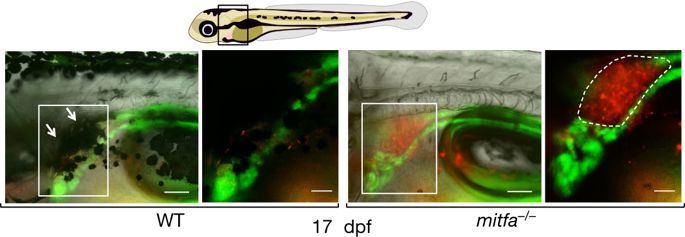Our official English website, www.x-mol.net, welcomes your feedback! (Note: you will need to create a separate account there.)
Protection from UV light is an evolutionarily conserved feature of the haematopoietic niche
Nature ( IF 64.8 ) Pub Date : 2018-06-01 , DOI: 10.1038/s41586-018-0213-0 Friedrich G Kapp 1, 2, 3 , Julie R Perlin 1, 2 , Elliott J Hagedorn 1, 2 , John M Gansner 4 , Daniel E Schwarz 5 , Lauren A O'Connell 6 , Nicholas S Johnson 7 , Chris Amemiya 8 , David E Fisher 9 , Ute Wölfle 10 , Eirini Trompouki 11 , Charlotte M Niemeyer 3 , Wolfgang Driever 12 , Leonard I Zon 1, 2
Nature ( IF 64.8 ) Pub Date : 2018-06-01 , DOI: 10.1038/s41586-018-0213-0 Friedrich G Kapp 1, 2, 3 , Julie R Perlin 1, 2 , Elliott J Hagedorn 1, 2 , John M Gansner 4 , Daniel E Schwarz 5 , Lauren A O'Connell 6 , Nicholas S Johnson 7 , Chris Amemiya 8 , David E Fisher 9 , Ute Wölfle 10 , Eirini Trompouki 11 , Charlotte M Niemeyer 3 , Wolfgang Driever 12 , Leonard I Zon 1, 2
Affiliation

|
Haematopoietic stem and progenitor cells (HSPCs) require a specific microenvironment, the haematopoietic niche, which regulates HSPC behaviour1,2. The location of this niche varies across species, but the evolutionary pressures that drive HSPCs to different microenvironments remain unknown. The niche is located in the bone marrow in adult mammals, whereas it is found in other locations in non-mammalian vertebrates, for example, in the kidney marrow in teleost fish. Here we show that a melanocyte umbrella above the kidney marrow protects HSPCs against ultraviolet light in zebrafish. Because mutants that lack melanocytes have normal steady-state haematopoiesis under standard laboratory conditions, we hypothesized that melanocytes above the stem cell niche protect HSPCs against ultraviolet-light-induced DNA damage. Indeed, after ultraviolet-light irradiation, unpigmented larvae show higher levels of DNA damage in HSPCs, as indicated by staining of cyclobutane pyrimidine dimers and have reduced numbers of HSPCs, as shown by cmyb (also known as myb) expression. The umbrella of melanocytes associated with the haematopoietic niche is highly evolutionarily conserved in aquatic animals, including the sea lamprey, a basal vertebrate. During the transition from an aquatic to a terrestrial environment, HSPCs relocated into the bone marrow, which is protected from ultraviolet light by the cortical bone around the marrow. Our studies reveal that melanocytes above the haematopoietic niche protect HSPCs from ultraviolet-light-induced DNA damage in aquatic vertebrates and suggest that during the transition to terrestrial life, ultraviolet light was an evolutionary pressure affecting the location of the haematopoietic niche.Melanocytes above the haematopoietic niche protect haematopoietic stem cells from ultraviolet-light-induced DNA damage in aquatic vertebrates throughout evolution; this niche moved to the bone marrow during the transition to terrestrial life.
中文翻译:

抵御紫外线是造血生态位的进化保守特征
造血干细胞和祖细胞 (HSPC) 需要特定的微环境,即造血生态位,它可调节 HSPC 的行为1,2。这个生态位的位置因物种而异,但驱动 HSPC 进入不同微环境的进化压力仍然未知。该生态位位于成年哺乳动物的骨髓中,而在非哺乳动物脊椎动物的其他位置也有发现,例如硬骨鱼的肾骨髓中。在这里,我们发现斑马鱼肾骨髓上方的黑色素细胞伞可以保护 HSPC 免受紫外线的伤害。由于缺乏黑素细胞的突变体在标准实验室条件下具有正常的稳态造血功能,因此我们假设干细胞生态位上方的黑素细胞可以保护 HSPC 免受紫外线诱导的 DNA 损伤。事实上,在紫外线照射后,未着色的幼虫在 HSPC 中表现出更高水平的 DNA 损伤(如环丁烷嘧啶二聚体染色所示),并且 HSPC 数量减少(如 cmyb(也称为 myb)表达所示)。与造血生态位相关的黑素细胞伞在水生动物中高度进化,包括七鳃鳗(一种基础脊椎动物)。在从水生环境向陆地环境转变的过程中,HSPC 重新定位到骨髓中,骨髓周围的皮质骨保护骨髓免受紫外线照射。我们的研究表明,造血生态位上方的黑色素细胞可以保护水生脊椎动物中的 HSPC 免受紫外线诱导的 DNA 损伤,并表明在向陆地生命过渡期间,紫外线是影响造血生态位位置的进化压力。在水生脊椎动物的整个进化过程中,生态位保护造血干细胞免受紫外线诱导的 DNA 损伤;在向陆地生命过渡期间,这个生态位转移到了骨髓。
更新日期:2018-06-01
中文翻译:

抵御紫外线是造血生态位的进化保守特征
造血干细胞和祖细胞 (HSPC) 需要特定的微环境,即造血生态位,它可调节 HSPC 的行为1,2。这个生态位的位置因物种而异,但驱动 HSPC 进入不同微环境的进化压力仍然未知。该生态位位于成年哺乳动物的骨髓中,而在非哺乳动物脊椎动物的其他位置也有发现,例如硬骨鱼的肾骨髓中。在这里,我们发现斑马鱼肾骨髓上方的黑色素细胞伞可以保护 HSPC 免受紫外线的伤害。由于缺乏黑素细胞的突变体在标准实验室条件下具有正常的稳态造血功能,因此我们假设干细胞生态位上方的黑素细胞可以保护 HSPC 免受紫外线诱导的 DNA 损伤。事实上,在紫外线照射后,未着色的幼虫在 HSPC 中表现出更高水平的 DNA 损伤(如环丁烷嘧啶二聚体染色所示),并且 HSPC 数量减少(如 cmyb(也称为 myb)表达所示)。与造血生态位相关的黑素细胞伞在水生动物中高度进化,包括七鳃鳗(一种基础脊椎动物)。在从水生环境向陆地环境转变的过程中,HSPC 重新定位到骨髓中,骨髓周围的皮质骨保护骨髓免受紫外线照射。我们的研究表明,造血生态位上方的黑色素细胞可以保护水生脊椎动物中的 HSPC 免受紫外线诱导的 DNA 损伤,并表明在向陆地生命过渡期间,紫外线是影响造血生态位位置的进化压力。在水生脊椎动物的整个进化过程中,生态位保护造血干细胞免受紫外线诱导的 DNA 损伤;在向陆地生命过渡期间,这个生态位转移到了骨髓。


























 京公网安备 11010802027423号
京公网安备 11010802027423号